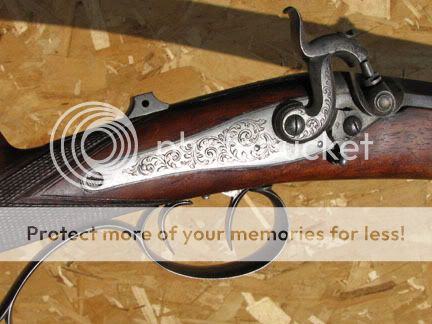Josh Smith
45 Cal.
- Joined
- Sep 24, 2010
- Messages
- 907
- Reaction score
- 0
CrackStock said:dear God man
are you suggesting carrying the hammer down on a cap?
you wont need to snag it on something to have an a.d. just let it fall hammer down or bump something hard enough and thats all she wrote
My good man,
Let's turn this around for a moment.
How safe is your use of a half cock notch as your safety device under your same scenarios?
Please do an experiment.
Lower the hammer of an unloaded caplock onto a cap.
(Check it twice and observe the muzzle discipline that we all learn since we first touched a gun)
Press the hammer down tightly so that the cap is prssed to make sure that it is well seated onto the nipple.
(I generally do this press fit when hunting to make sure that the first shot is effective when it is needed. If you cannot lower the hammer safely, you should not be handling a gun of any type)
Now try to make it fire.
Pull the trigger. Hopefully nothing happens here since the hammer is down and has nowhere to go.
Press down on the hammer all you like. Am I confused in thinking that force will not set off a cap? Impact will set off a percussion, but not simple pressing force.
Bump the rifle to your heart's content.
Now for the scary ones.
Tap the hammer (Only while pointed in a safe direction and of course, unloaded, but capped.)
Tap harder.
Now the worst - pull the hammer back and see how far it must travel to get the cap to fire.
Somewhere along the line, it will fire the cap -- it is supposed to fire the cap. But the idea is to learn what it actually takes to make this happen.
In my less than scientific attempts, it was pretty hard to make the cap fire without pulling the hammer back at least some distance.
Why would I go to these lengths?
Mostly because I am curious and want to learn.
But also because, I have witnessed the NPS and other organizations' test of half cock notches prior to permitting MLs to be used to participate in various events. They dangle the weight of the gun on the trigger while the hammer or cock is set at half cock. This over stresses that fairly weak area. This to my thinking is a primary cause of failure of half cock notches. I have also seen guns fail that test with a fair degree of frequency.
With this experience in mind, I sought some alternative method of safe carry. In discussions with fellow shooters and hunters, I learned that some find that hammer down may actually be safer for a percussion system.
As to the other comment posted above regarding using an old fired cartridge casing placed over the nipple as a cover to serve as a safety device, I added the comment about spent .22 casings fitting the top conical portion of some #11 nipples. Others mentioned other pistol caliber cartridges. This idea is safe, convenient and cheap. Just learn what fits your nipple. I have used this method on my Tennessee and it worked fine -- it is my first choice.
I do prefer this carry condition over the half cock notch or hammer down carry methods.
YMHS,
CrackStock
Crackstock,
I just saw this.
Regardless of what others say here, this is, in theory, safe.
Mercury fulminate was very explosive and very sensitive. Having the hammer down on a primer and smacking it with a hammer would have set it off.
Today's stuff isn't as sensitive. It's still there, and you do run a risk of setting it off, but not nearly the risk you did in yesteryear.
If you look at modern weapons, they use the same cap concept, only it's self-contained. The anvil is inside the cap instead of being in the form of a nipple.
Now you have to ask yourself, why do inertial firing pins exist? If it were truly safe (outside of theory, that is) to carry a hammer down on a live cap or primer, there would be no reason to have inertial firing pins.
I will most certainly try your experiments next time I have an empty muzzleloader (I store them with charges in the barrel; that's something else people don't like, so you're not alone). I do bet I set one off.
I would also bet that, if I were to take a piece of leather from, say, a thin belt or a bullwhip, and put it on top of the cap before lowering the hammer, I wouldn't be able to set it off by tapping with a mallet.
Just some food for thought.
Regards Sir,
Josh






